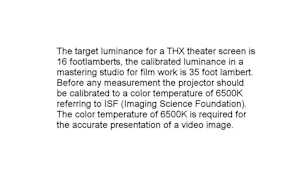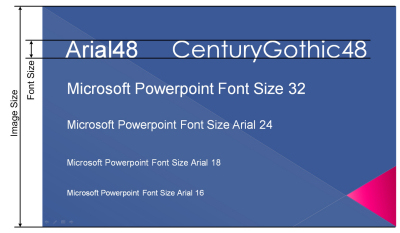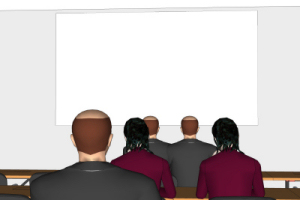
rule of thumb for screen height
The screen should always fit to the audience, not to the projector! A rule of thumb for screen sizes is the four-six-eight rule -468-. The farthest viewer should be no more than four, six or eight times the image height away from the screen. The three options depend on the following conditions:
- four times for material with fine details like CAD drawings or other detailed graphics
- six times for detailed reading (spreadsheets, text, images with text)
- eight times for watching movies or images

| CAD: X = 4 * h | Powerpoint: X = 6 * h | Movies: X = 8 * h |
Important: this rule evolved with the majority of projections in the format XGA (1024 x 768). With formats like SXGA, SXGA+ and HD(1080) this changes because the screen height is not built by 768 pixels but by 1024, 1050 and 1080 pixels. This is an increase of about 35 to 40 percent. All details that are presented in native pixel resolution become smaller for 35 to 40 percent !
Also the image height should be within the following range:
Distance of farthest Viewer / 8 < Image Height < Distance of closest Viewer / 2
Text size depends on pixel size and image resolution. A Powerpoint Presentation will scale the slide size to the image size but a Excel sheet will be displayed depending on the pixel size.
With higher resolution the presentation should be zoomed in:  or a larger screen could be considered.
or a larger screen could be considered.

|

|
WXGA (1280x800) image from an Excel sheet, text size Arial20 | WUXGA (1920x1200) image from the same Excel sheet, text size Arial20 |
Higher resolutions always have the disadvantage of smaller text sizes, except the text is zoomed.
 |  |
The distance visual acuity is the visual sharpness or clearness of human eye view. With normal viewing abilities two objects can be just seen individually with an viewing angle of 1 arcminute (MOA). This equals approximately an object distance of 1,5mm at a distance of 5 meters or 1,75mm at a distance of 6 meters (20 feet).
Normal visual ability means that a person who can see this clearly has a Distance Visual Acuity of 5/5 (Europe) or 6/6 (Britain) or 20/20 (US). If a person is tested for a visual acuity of 6/12 (or 20/40), she or he can differentiate two objects only at half distance. The term "6/12" means that two objects with a separation of 1 arcminute at a distance of 12 meters can only be seen separately at a distance of 6 meters, the term "20/40" means equally that two objects with a separation of 1 arcminute at a distance of 40 feet can only be seen separately at a distance of 20 feet.
| Visual Loss | Visual Acuity | |
| no or slight loss | 6/6 - 6/18 | 20/20 - 20/60 |
| moderate loss | 6/18 - 6/60 | 20/60 - 20/200 |
| severe loss | 6/60 and more | 20/200 and more |
Based on the rules of visual acuity letters and numbers should have at least five times the height of the minimum distance between two recognizable objects. This results in a minimum letter and number hight of 5 arcminutes, there as 7 arcminutes are acknowledged for general good readability.
 | calculate with this Excel file, download here
|
Powerpoint and similar presentation tools display letters and numbers in relative size to the entire image area not pixel-dependent. In any other regular PC application letters and numbers are displayed by pixels depending the font size chosen in the application. With a higher display resolution letters become smaller. The same application on a WXGA resolution (for instance 1440x900) looks 'larger' than on a WUXGA resolution (1920x1200), displayed pixel by pixel.
With a Powerpoint application, the actual displayed font size depends only on the relation to the entire screen size, not on the relation to the pixel resolution. In other words, the same Powerpoint presentation displayed on WXGA or on WUXGA 'looks' the same.
The letter size (letter height of a capital B) can be calculated for 19:10 Powerpoint presentations:
Letter Hight h (mm) = Image Height H (m) * 1,63 * Fontsize
Image Height H (m) = Letter Height h (mm) / ( 1,63 * Font Size)
For instance: necessary letter height is 68mm, font size is '16'. What is the needed minimum image height?
H = h / (1,63 * 16) = 68mm / (1,63 * 16) = 2,6m
 |
| relation between image height and letter height in a Powerpoint presentation |
In a situation with restricted space and a projection display mainly used for Powerpoint presentations a compromise with a smaller image size and a defined minimum font size can be calculated. As long as this font size is guaranteed the 'small' display can still be used satisfactory.
The projector's throw ratio is the ratio between the distance to the projection screen and the width of the projection screen. Throw Ratio = Throw Distance / Screen Width Throw Distance = Screen Width * Projection Ratio For instance: A screen width of 1 m and a throw ratio of 1.3 results in a throw distance of 1,3 m. With the same distance of the projector the image width will get larger if the throw ratio is getting smaller. Or with the same image width the distance gets smaller if the projection ratio is getting smaller.
The bottom of the screen should be in a high enough vertical position, allowing those seated in the rear of the audience to see the screen completely. The distance between floor and screen should be about 1.1 to 1.2 meters (43" .. 48").

|

|
| distance between floor and screen: 0.9 meters (35") - too low | distance between floor and screen: 1.2 meters (47") |
The maximum acceptable viewing angle should be 45 degrees. Beyond that characters and image elements become undecipherable. Ideally, all viewers should be seated within 30° of the projection axis, and never more than 45° off axis.
Screen center should be no more than 20° above the eye level of any viewer.

Using keystone correction and warping always usable light output and usable resolution is increased. The higher the resolution the better both methods work because of smaller irregularities within the resulting image.
 |
 |
| projection on axis |
projection off axis using warping as correction tool, resulting in the same image size as with projection on axis, but over 25% of light output and resolution lost ! |